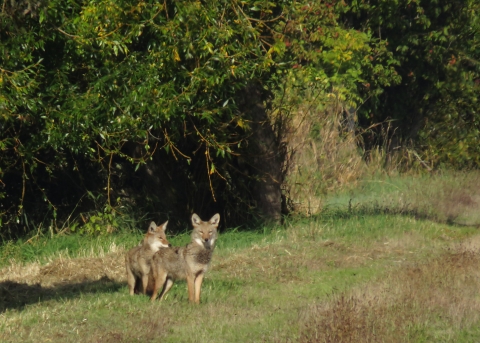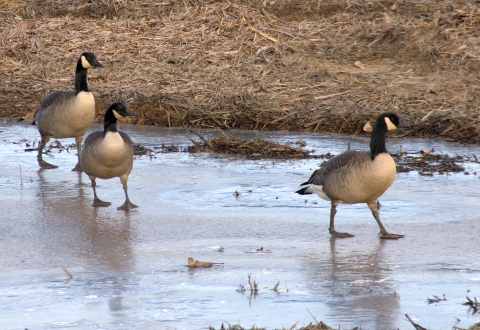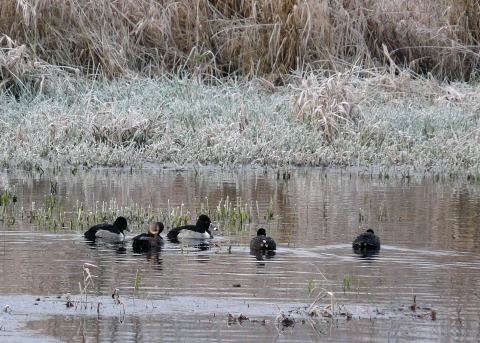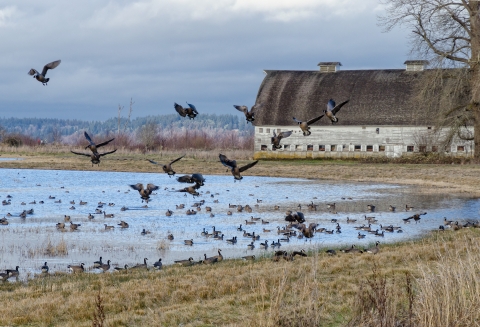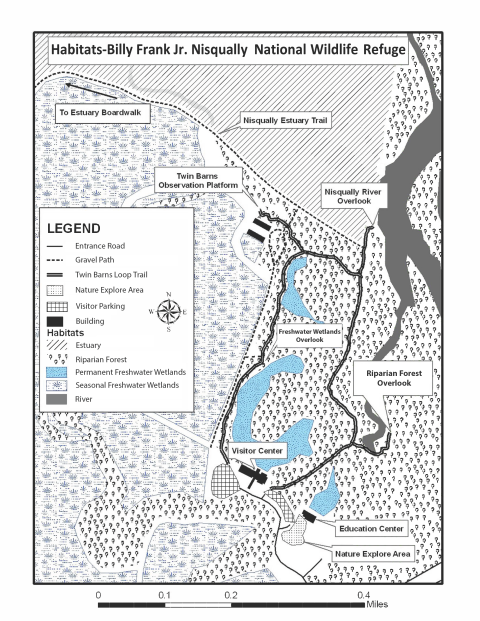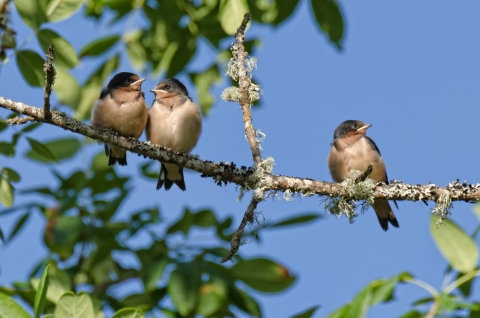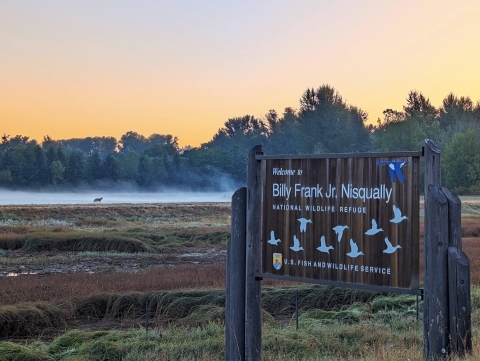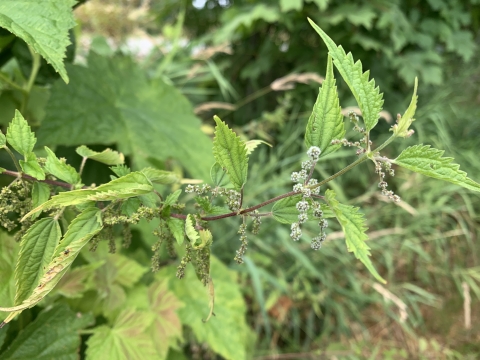Seasons of Wildlife
Spring
In March, as rains become less frequent, bald eagles begin nesting. Spring migrants begin to arrive; the last week in March may be the best time to see and hear spring migrant birds. Early flowering salmonberry and Indian-plum provide nectar for returning rufous hummingbirds. In April, bald eagle pair incubates eggs and chicks usually hatch later in the month. Late April and early May bring flocks of approximately 5,000 western sandpipers and dunlin to forage on delta mudflats during northward migration. The air is sweet with flowering shrubs and trees. Insects attracted to new leaves are plentiful food for songbirds. Wet and cloudy weather gives way to occasional clear days in May and ground nesting birds are underway. Bird songs fill the air as breeding begins.
Summer
June brings dry, sunny seasonal weather and songbirds are feeding their young. Chinook salmon move up the Nisqually River to spawn in tributaries until September. Juvenile eagles are seen flying and foraging on the Refuge in July. Native woodland and forest shrubs are producing abundant fruit for wildlife consumption. Habitat management is active in August and the mowed grasslands reveal coyotes hunting down small mammals. As the freshwater wetlands are reflooded, migratory waterfowl on their southbound journey stop to feed on new growth. Shorebirds migrate southward, stopping briefly to feed on Refuge intertidal flats.
Fall
September brings the wet season, with more frequent drizzles and rain. Migratory waterfowl begin to arrive -the diversity and abundance increases through the season. Wintering songbirds start arriving (Northern shrike, winter wren, ruby-crowned kinglet, golden-crowned kinglet, varied thrush, yellow-rumped warbler, and sparrows). Peregrine falcons, merlins, and American kestrels arrive to forage on wintering birds while bald eagles hunt waterfowl flocks. By November, there is an abundance of waterfowl. Chum salmon return to spawning grounds in Nisqually River tributaries. Raptors become increasingly abundant throughout the winter.
Winter
In December, it's not unusual to see 4,000-6,000 wintering geese and waterfowl in the seasonal wetlands, pastures, and estuary habitats. The earthy, sweet smell of the Pacific Northwest permeates the air. The freshwater wetlands are fully flooded with seasonal rain by January and overwintering waterfowl are abundant. There is a peak of chum salmon in the Nisqually River and bald eagles are positioned along the river and on the Delta to take advantage of the lower tides and concentration of fish. February is the best time to observe sea ducks and black brant in the Nisqually Reach. Waterfowl are gaining their storage before migrating north. As February winds down and rains are warmer, we hear chorusing Pacific tree frogs.
Featured Species
Billy Frank Jr. Nisqually National Wildlife Refuge was established to provide habitat for migratory birds. Estuary habitat is essential for migratory birds of every sort. Approximately 85% of estuarine habitat throughout Puget Sound has been destroyed by human encroachment and development. This makes protected lands like Billy Frank Jr. Nisqually Refuge critical to the continued survival of migratory birds. In addition to protecting waterfowl, the diversity of habitats that exist in a natural estuary also provide food for seabirds, shorebirds, songbirds, and raptors.
There is nothing more fundamental to our mission than management and restoration of habitats. A variety of hawks, owls, and other raptors hunt in the fields and marshes. Woodpeckers, warblers, and small mammals are found in the woodlands. Shorebird flocks search for food in the mudflats, while harbor seals rest in the salt marshes nearby. Freshwater ponds provide habitat for migratory waterfowl, herons, beavers, and otters. Mixed conifer forests on the bluffs above the Delta provide perches and nesting for bald eagles. Salmon and steelhead use the estuary for passage to upriver areas and transition to the sound.
Here are some of the birds commonly spotted at the refuge:
- American goldfinch, Carduelis tristis. Bright yellow with a black cap and wings. Common in flocks in weedy fields, bushes, and seed-bearing trees.
- American wigeon, Anas americana. Mostly brown with a white wing patch in flight. Males have green on the heads and a buffy-white band from the front of the bill to the top of the head. Wigeons are surface feeders and prefer aquatic plants. Look for them in the seasonal wetlands.
- Bald eagle, Haliaeetus leucocephalus. Adults are dark brown with white head and tail and yellow beak and feet. Eagles younger than 5 years have mottled brown and white feathers without any pattern. Bald eagles eat fish and fowl, dead or alive. They are often seen perched in the refuge's highest cottonwood trees, as well as gathering on the mudflat near the mouth of McAllister (Medicine) Creek.
- Barn swallow, Hirundo rustica. Iridescent blue back, cinnamon-colored belly and throat. Deeply-forked, long tail. The open, cup-shaped mud nests of barn swallows are often seen attached to the refuge's buildings. Look for them swooping over water to catch insects on the fly.
- Belted kingfisher, Ceryle alcyon. Gray-blue on the head and back, white breast. Males have a gray band across the chest, females a rust-colored band. Kingfishers dive into the water to catch fish with their long, robust beaks. Their rattling calls are loud and distinctive. Look for them near rivers, streams, and large ponds.
- Cackling goose, Branta hutchinsii. Black head and neck with white "chinstrap," brown body. Mostly eat plants, and may dabble like ducks. They also eat grain and seeds in fields and wetlands, along with some insects, molluscs, and crustaceans. Named for their distinctive calls, lighter than a Canada goose's deep, loud honks.
- Cinnamon teal, Anas cyanoptera. Cinnamon brown all over. Males have orange-red eyes, yellowish legs, and a bright blue wing patch. Look for them in ponds and wetlands.
- Common yellowthroat, Geothlypis trichas. Males have a broad black mask topped with white, and a bright yellow throat and breast. Females are more olive-toned and lack the black mask. They cock their tails like wrens. Look for them in the wetland vegetation, in shrubs, and in fields. Their song is a loud, rolling wichity wichity wichity wich.
- Dark-eyed junco, Junco hyemalis. These sparrows have light pink bills, gray or black hoods, and white outer tail feathers easily seen when they fly. Often in flocks, they hop on the ground and pick up small seeds.
- Double-crested cormorant, Phalacrocorax auritus. Heavy black bird with a long, kinked neck and orange throat pouch. These are often seen along the Estuary Boardwalk, in the water or on the bank.
- Great blue heron, Ardea herodias. One of our largest wading birds, this species stands 4 feet tall. Slate blue with white head and black stripe above the eyes, white neck streaked with black, long and formidable yellow beak. These can be seen in all the wet areas of the refuge, waiting for and eating fish, frogs, rodents, and snakes.
- Great horned owl, Bubo virginianus. Large owl, mottled brown, gray, and white, with tall "ears." Eats other owls and prey as large as skunks. Seen in the forested areas of the refuge and near the Twin Barns.
- Mallard, Anas platyrhynchos. Males have metallic green head and neck, yellow bill, narrow white collar, and chestnut breast, with upcurled black tail feathers. Females have brown-patterned feathers. Both have orange legs and feet, and an iridescent purple-blue patch in the wing edged with white. They are seen in ponds and wetland throughout the refuge. They feed by dabbling at the edge of the water, bottoms-up.
- Marsh wren, Cistothorus palustris. Small brown bird with a strong white line above the eye, black and white barring under a jauntily upright tail, and buffy-white breast. Looks for them in the reedy freshwater marshes.
- Northern flicker, Colaptes auratus. Woodpeckers with black spots on a buffy breast, a black crescent-shaped collar, black eyes, and a brown back with black barring. White rump patch and yellow-orange color under wings are tail seen in flight. Northern flickers are very find of ants and are seen on the ground, as well as in large trees.
- Northern harrier, Circus hudsonius. When flying, white rump patch is diagnostic. Females are brown above, males gray; both are white below. They fly slowly close to the ground, searching for rodents, frogs, and small birds. They have feathers arranged in a disc around their face, much like an owl's, helping them hear their prey as well as see it.
- Northern pintail, Anas acuta. Male has a chocolate brown hears with a fine white stripe running vertically down to a white chest, and delicately filigreed gray back and sides, a black and white rump, and a long black tail often held at a 45 degree angle. Females are patterned with brown and white, with a brown head and dark bill. These plant eaters are often seen in the freshwater wetlands.
- Northern shoveler, Anas clypeata. Males have green head with yellow eye, white chest, chestnut brown side, black and white back and tail, and a metallic green wing patch. Both sexes have orange feet and unique broad bills (male bills are black, female bills are orange). Frequently seen in the freshwater wetlands, often swinging their bills from side to side or spinning in circles together while they filter out food from the water.
- Pied-billed grebe, Podilymbus podiceps. The pied bill is white with a black stripe and notable short. Dark eye encircled by a narrow white ring. This grebe is small and dark, seen in the ponds and wetlands of the refuge.
- Red-winged blackbird, Agelaius phoeniceus. Males are jet black with red or orange patches in the wing. Females look a lot like starlings, brown and stripey. Both are stocky, with rounded wings and relatively short tail. Common in the cattails and reeds of freshwater wetlands. The male's song is loud and easy to recognize, a metallic conk-la-lee.
- Red-breasted nuthatch, Sitta canadensis. This little bird is slate gray on the back, buffy-orange on the belly, with a small black cap, white stripe above the eye to the nape of the neck, black eye stripe, and white chin. It moves around and down tree trunks facing down, probing with its narrow, sharp beak for insects. Seen in the forested areas of the refuge.
- Ring-billed gull, Larus delawarensis. Adults have black ring around yellow bill, pale eye, greenish-yellow legs, gray mantle, white head and underparts, and black primary feathers tipped with white spots. Head is streaked with brown in winter. Their plumage changes in their 1st 3 years. Commonly found in the estuary.
- Song sparrow, Melospiza melodia. Long, rounded tail, pumped in flight. Broad, grayish eyebrow and broad, dark stripe bordering whitish throat. Upper parts usually streaked. Breast heavily streaked with lines converging at a central spot. Legs and feet pinkish. Commonly found in brush all over the refuge.
- Wood duck, Aix sponsa. Large head with a slicked-back crest, short neck, and long square tail. Male is spectacularly patterned and colored in chestnut, white, black, and green, with a bright red eye. Female has a wide white eye ring, an bit of a crest, brown feathers, and a blue wing patch with white border. They are plant eaters, nesting in tree cavities. The refuge has nest boxes hung in forested areas of the refuge. Often seen in ponds.
Mammals often seen at the refuge include these:
- Beaver, Castor canadensis. These mammals are very large rodents. They have webbed feet and a long, flat tail. They eat vegetation, but are best known for chewing down trees with their long, orange, continually growing incisors. They are most often seen in the early morning or evening, in the river or in ponds.
- Coyote, Canis latrans. Coyotes have large pointed ears and long, bushy tails. Their coloring is a mix of gray and orange-brown. They eat 90% rodents, rabbits, fawns, squirrels, and other mammals; as well as birds, snakes, and large insects. Watch for them out in the fields.
- Black-tailed deer, Odocoileus hemionus columbianus. Dark brown or black flattened tails with white underneath give this deer its name. Deer browse on brush: salal, blackberry, maple, salmonberry, Douglas-fir. They also eat grasses, berries, apples, ferns, and lichen. They are seen in wooded areas and meadows at the refuge.
- Muskrat, Ondatra zibethicus. Muskrats are easily mistaken for beavers, but are smaller and have a long, bare tail that is not flat like a beaver's. They eat plants, and are seen in ponds and wet areas.
- Northern red-legged frog, Rana aurora. Upper surface and sides are usually reddish brown, with a few dark spots or blotches, while the underside of belly and inner legs are a pinkish red. This frog doesn't usually make any sound. Found in ponds and freshwater wetlands.
- Pacific chorus frog, Pseudacris regilla. Also called a tree frog, coloring varies widely, from green to brown, even (rarely) blue. A dark streak runs through each eye. These are small frogs, abundant near permanent freshwater. Look carefully on blackberry leaves, elderberry stems, shelf fungi... The call sounds like wreck-it.
- Mink, Neogale vison. Related to otters and ferrets, mink are about the size of a small house cat. Slender body, short legs, dark brown fur, long furry tail. They are seen near the ponds and wetlands, hunting for muskrats, voles, young birds, and frogs. They are excellent swimmers.
- Otter, Lontra canadensis. Also called land otter or river otter, they are in the weasel family. Long bodies, short legs with webbed feet, long muscular tail, flat head with small eyes, brown fur. These excellent swimmers are seen in the ponds and rivers of the estuary and in nearby saltwater. They eat salamanders and frogs, fish, clams, mussels, crabs, turtles, and sometimes mice, squirrels, and birds. They can dive up to 60 feet deep and stay under up to 4 minutes.
- Townsend's vole, Microtus townsendii. A mouse-like mammal with rounded nose, short tail, and relatively small ears. Common in both grassland and woodland. They eat seeds, roots, berries, and mushrooms, scattering seeds and spores to the benefit of the species they target. Their tunnels help allow water to absorb in to the soil.
A great range of plants is found at the refuge. Here, we describe some of the common ones found in different habitats:
Freshwater Marsh Habitat:
- Pacific willow, Salix lasiandra. Tree can grow to over 60 feet. Bark is dark gray to dark brown. Leaves and narrow and long, tapering to a slender tip. Yellow, hairy catkins appear in spring.
- Water-starwort, Callitriche heterophylla. This widespread aquatic plant is found in ponds, stream, and even mudflats, usually in still or slow-moving water. The seeds and leaves are eaten by ducks.
- Cattail, Typha latifolia. Leaves sprout annually from a starchy rhizome. Tall stems (up to 10 feet high) bear the fruiting body, which looks like a fuzzy brown hot-dog by the end of summer. This plant indicates permanent standing freshwater. The entire plant is edible, consumed by muskrats, geese, and mallard ducks.
- Reed canary grass, Phalaris arundinacea. This is a non-native, invasive grass, prolific in the Pacific Northwest and impossible to eliminate. It can form dense thickets in wetlands. We drain and mow our seasonal freshwater wetlands in part to control this invader. When mowed regularly, it keeps thickets from forming and allows wildlife to feed on the young leaves.
Grassland and Shrub Habitats:
- Non-native grasses make up the bulk of the grassland at the refuge, and can be difficult to identify.
- Black medic or hop clover, Medicago lupulina. Low-growing plant with the 3-leaf arrangement typical of clovers. Bright yellow flowers that produce nectar for bees. Another non-native plant, in the same genus as alfalfa.
- Canada thistle, Cirsium arvense. It not from Canada! A native of Eurasia. Spiny leaves and deep-seated, creeping roots make this plant hard to eradicate.
Woodland and Riparian Habitat:
- Black cottonwood, Populus trichocarpa. Cottonwood keeps near water. Heart-shaped leaves turn gold in the autumn. Winter buds are sticky with fragrant resin. Long catkins in spring produce cottony seeds that fly in the wind later in summer-- usually around the same time that other wind-pollinated plants are invisibly in bloom, causing people to assume they are allergic to cottonwood when they are actually allergic to the pollen of grass and ragweed. Beavers especially love the inner bark of this tree, which has developed the ability to sprout after it is felled in response to millennia of co-evolution with the dam-building rodents.
- Red alder, Alnus rubra. A common tree capable of growing in poor soil and areas that occasionally flood. Leaves are serrated like a steak knife. In spring, yellowish tassels produce pollen; and small green cones develop later into brown, woody cones that last all winter and well into the next year. Alder bark is a host for a diversity of lichen, making the trunks of the trees appear blotched with white and pale green.
- Bigleaf maple, Acer macrophyllum. This common, native maple has enormous leaves with five points, like the fingers of a hand. Spring flowers attract many pollinating insects as well as hummingbirds. The tree often rots from within, providing excellent habitat for birds, raccoons, insects, frogs, and fungi.
- Scouring rush, Equisetum hyemale. Closely related to horsetail, scouring rush never has branches. The stems are hollow and segmented; and the tissues contain silica, make them abrasive. They can grow up to 3 feet high in wet ground. Look for this plant in abundance from the Riparian Trail, growing underneath cottonwood and alder in an occasionally-flooded area.
- Skunk Cabbage, Lysichiton americanus. Where tidal flooding pushes upstream in the riparian riparian
Definition of riparian habitat or riparian areas.
Learn more about riparian forest, skunk cabbage thrives. Its spring bloom is a fleshy stem tightly packed with small flowers, hooded by a bright yellow leaf-like shield. These are the first parts seen in spring, followed by very large leaves that get bigger and bigger throughout the season. This plant is named for its strong skunky odor, which attracts flies to pollinate its flowers. - Snowberry, Symphoricarpos albus. This shrub resembles blueberry, but it is a member of the honeysuckle family. Its white berries, born in small clusters, are easy to recognize, and are not edible for people. Look for it in the understory below trees.
Salt Marsh Habitat:
- Lyngby sedge, Carex lyngbyei. This highly nutritious sedge is eaten by all kinds of wildlife, from geese to bears. It is salt-tolerant, so is found in the estuary. Tall round stems have a purplish-brown base. Male and female flower spikes are seen April-July.
- Pickleweed, Salicornia pacifica. Abundant in salt marshes throughout Puget Sound, pickleweed can filter out salt into special parts that drop off the plant. The stems are segmented, and flowering stems have a purplish or reddish cast.
- Puget Sound gumweed, Grindelia integrifolia macrophylla. The bright yellow flowers of this native plant look like sunflowers. A sticky succulent with a strong odor, gumweed produces a gooey white sap.
Watch Out for These Plants!:
- Stinging nettle, Urtica dioica. This plant is delicious and nutritious, but well-defended with tiny hair-like needles that inject a potent chemical mixture that itches and burns. This does no permanent harm, but can be unpleasant for a while. It is abundant in disturbed areas in damp woods and alongside streams and ponds. It grows alongside our trails and may hang over rails, so beware!
- Bittersweet nightshade, Solanum dulcamara. A Eurasian vine that has spread throughout the world. Its flowers are little blue or purple stars with yellow centers, born in loose clusters. It likes wet soil and is spread by some birds that are immune to its poisons. The berries change from green to yellow to orange to red and look like tiny tomatoes. Do not eat!

